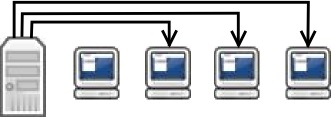Unicast, Multicast, Broadcast. What Does It Mean?
By Stephen Bucaro
Unicast, Multicast, and Broadcast are different network transmission methods.

Unicast is a transmission between a single sender and a single receiver
identified by a unique address over a network.

For video, even though multiple client computers might request the same video
at the same time, a separate unicast data stream is transmitted to each client computer.

Multicast is a transmission between a single sender and multiple receivers
simultaneously. The clients that receive the multicast may have a common set of criteria,
or be specifically set up as a multicast group. A special kind of multicast, referred to as
"anycast" is a communication between any sender and the nearest receivers in a network.

Broadcast is a transmission from a single sender to all clients on the network.
Routers can be used to divide a network into separate broadcast domains. A broadcast is
then limited to a broadcast domain. The IP address 255.255.255.255 indicates a broadcast,
and this address is never forwarded by routers.
More Networking Protocols and Standards:
• RADIUS Protocol
• Unicast, Multicast, Broadcast. What Does It Mean?
• Networking Routing Believability and Administrative Distance
• Basic TCP/IP Networking
• Network Switches
• IPv4 Datagram Fields
• TCP/IP Features
• Kerberos Authentication Protocol
• Video Streaming Protocols
• Network Cabling and Components
| 
